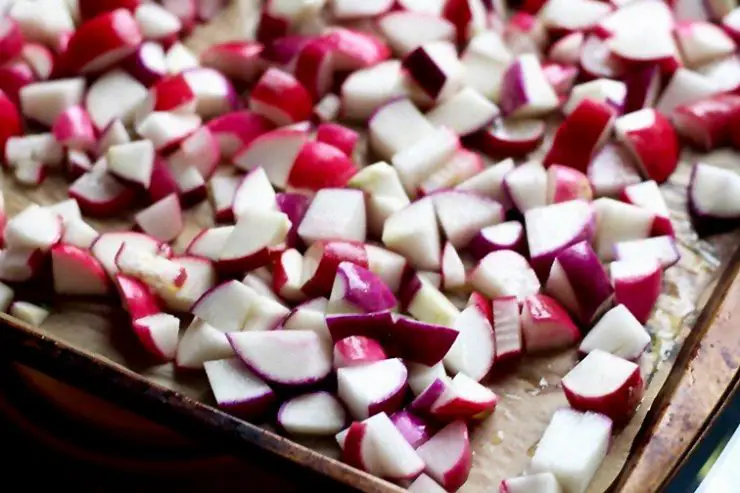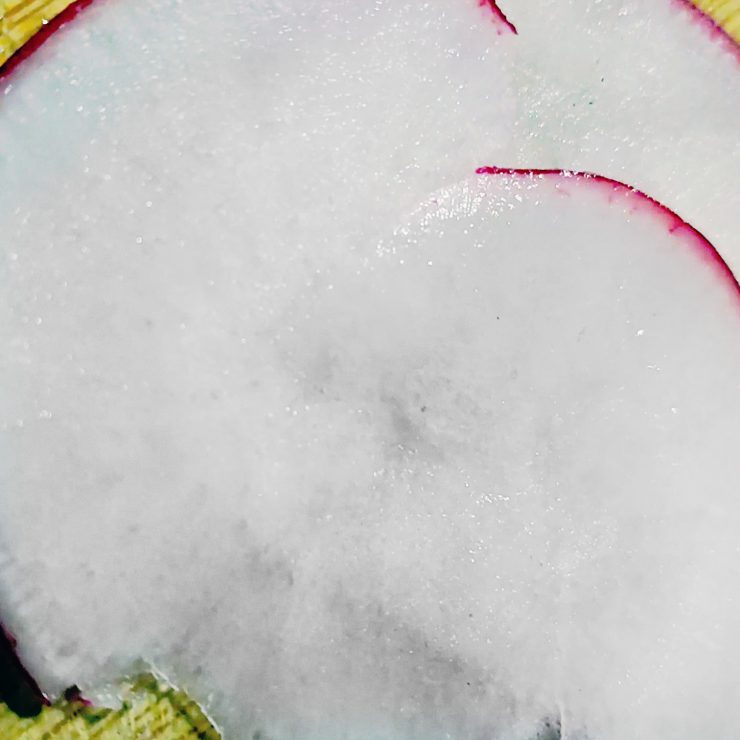Table of Contents
The radish is a nutrient-dense root crop that packs an incredible health punch. It contains juice and comes in many colors, but more usually white or red. The benefits of eating this vegetable aren’t just limited to your digestive system either – research shows they may help prevent some diseases such as fibrosis which affects the liver and causes all kinds of problems. Maybe you already heard, that radishes have been used for centuries as a natural remedy. The radish is considered to be one of the most healthy root crops, which can actually help treat common stomach problems.
How much radish is too much?

If radish is so good, there shouldn’t be a problem eating a whole lots of it, right? Well, not exactly. It’s a well-known fact that members of the Brassicaceae family are known for causing gas and flatulence buildup. This plant family includes other usual suspects when it comes to belly gas, like broccoli, Brussels sprouts, cauliflower, all kinds of cabbages. Which means, that can also suffer from stomach discomfort if you eat too many radishes.
But it’s definitely not all bad news! Radishes are a good source of dietary fiber, which aids in digestion and helps to prevent constipation. However, radish can also cause stomach discomfort in some people. One reason for this may be gas buildup. When we eat foods that contain dietary fiber, such as radishes, the bacteria in our gut ferment the fiber and produce gas. This gas can sometimes cause bloating, cramping, or flatulence. If you’re experiencing stomach discomfort after eating radishes, it’s best to cut back on your consumption to see if that helps.
Radishes are one of the healthiest and most versatile vegetables you can include in your diet. They contain an impressive amount vitamins, minerals like vitamin C which helps keep our skin healthy! However don’t forget about their size- they’re not just for snacking on but rather should be treated lightly when included as part of overall wellness meal plan due to high fiber content that takes time digestion system resources from other nutrients we need throughout each day
The radish benefits seem undeniable; However, remember to maintain reasonable portion size, as it may cause discomfort if eaten too often or too much without other ingredients.
How many radishes per day should I eat?

Considering the information above, you must be wondering now, so how many radishes is actually good for me to eat daily? Well, what works well for someone else may not work at all on you – or even make matters worse! For example, if you have IBS or another digestive disorder, the right amount for you could be incomparable to anyone else, or even zero. However, if you don’t have any digestive issues, you may be able to tolerate them in quite moderate amounts.
Radishes are safe to eat everyday in moderation as part of a healthy diet. Most sources agree, that one half cup or 120 grams per day is a good amount to consume. Adding radishes to your meals or eating them as snacks is a great way to make sure you’re getting your daily quota. Having a maximum of 120 grams per day should be enough to take full advantage from this vegetable, considering that you do otherwise have a normal, healthy and rich diet. It’s actually a fantastic low-carb snack for people who want to limit their carbohydrate intake. They’re also rich in several vitamins and minerals, with only 15 calories per cup!
However, the portion size of this food may be difficult to estimate due its high fiber content. We recommend starting lower, at about 50-70 grams per day, if you want you can increase this gradually and find out what works bests for you. Just remember, that radishes could be hard on our digestive systems when eaten raw, in larger amounts.
Consider time of the day
The best time to eat radishes is between morning and afternoon, as this will give your body enough time for digestion. It’s also wise if you like raw vegetables-the high fiber content takes longer than other ingredients do! You should avoid consuming them at night because we’re mostly inactive during these hours which may prolong the digestive process even further. The radish is a powerhouse of vitamins and minerals that keep our body functioning at its best through the day. The high water content means we’ll feel fuller for longer, while fiber also helps with digestion to look after your health during brunch!
Consider the serving type or cooking method
The timing for eating radishes will depend on the kind of dish you’re enjoying. If it’s a salad, wrap or sandwich filling then we recommend consuming them during day.
On the other hand, the fiber and sugar in these radishes break down over time as they soak in pickling liquid or kimchi mix, which means that the time restriction may not apply to these serving methods. Also, they usually only contribute as a small part of your meal since both are side dishes. It is also known, that Kimchi and radish pickles do not cause any digestive issues as they have probiotic bacteria that aid in digestion. Which means that you can usually eat them without any trouble.
Even though, garden fresh radish water content could add up to 94% of it’s weight, you can still roast, stir-fry or bake this vegetable. Just check out this beautiful serving of diced radish roots with basil and crushed pistachios below:
Boiled and steamed vegetable contains fewer burning substances that can cause problems with the digestive tract. However, even in this form you should not eat it more than 150-200 grams per serving. In general, the frequency of consumption should not exceed several times a week. Also, if you don’t really like the taste of plain radish, try mixing in some other vegetables, sour cream, vegetable oil and fresh garden herbs. Also, heat treatment can reduce the spiciness, which has not a very positive effect on the gastrointestinal tract.
So are there still any benefits of eating raw radishes?

We recommend eating your vegetables raw – there’s absolutely no reason why you should not consume them this way. Eating radish raw is the only way to get all benefits, including all of these amazing qualities that could be lost while cooking or preserving food. You should already know by now, that cooking at high temperatures will definitely degrade nutritional content of any vegetable. It’s a general rule, that applies to most of vegetables – you should try and consume them raw whenever possible. This goes without saying for most of the seasonal fruits and vegetables.
Here are few more reasons to consume radish raw
Easiest and quickest way to put something in your belly. All you need is to wash them and you’re all good to go;
It takes more time for your body to process raw food, that means that you will feel more full during the day and consume less calories overall;
Less preparation. Time and food resources saved without peeling, cooking and washing dirty dishes;
Health experts, fitness specialists, they all agree: the best way to get all of those health benefits is by eating fruits and vegetables raw. Ask any nutritionist, they will tell you why!

Plenty of easy recipes that goes great with other fresh vegetables. Eat at home or take out to a picnic, it’s your choice!
Just think about freshness: it can’t get any better. Straight out of garden, picked just before eating. Beat that, pickles!
It is worth mentioning, that not everyone’s taste buds will be delighted by the various radish varieties. For example, while some may find watermelon to be quite pungent and black radish to have hot – spicy features – both of which make them less appropriate for certain recipes. Especially when preparing meals for kids, Daikon can also come across differently depending on when it is harvested: being more savory if pulled late in season versus having sweetness from its young roots that are still developing. As always: A few types do not suit all individuals.
All in all, subjective things could be hard to figure out just by reading online, so the best thing you can do is experiment and watch your bodily response. Take note of a few dishes with radish, which brings the most benefits without sacrificing taste or causing uncomfortable feeling in the stomach and make sure to keep your diet diverse and varied in terms of nutritional content.
Here is what our curious readers asked recently:
Q: Are radishes hard to digest?
A: Not really, but they could cause other problems considering their natural chemical composition;
Q: Do radishes give you gas?
A: There are a few reasons why radish may give you gas. It’s is a high-fiber food, and when we eat foods that are high in fiber, it can sometimes cause gas and bloating. So when we eat foods like radish, brocoli, cabbage that are high in fiber, we can sometimes get more gas than usual;
Q: Do radishes contain sulphur?
A: Radishes are known to be reliable source of dietary sulfur, in addition to other nutrition elements;
Q: Do radish causes burps to smell eggy?
A: Methyl mercaptan occurs naturally in some foods (e.g., onions, radishes, asparagus, some nuts and cheese), eating lots of raw radish could cause your burps to develop distinctive putrid smell. Mixing radish with other foods, eating it cooked or reducing the intake of raw radishes will immediately diminish the problem.
Yep, it looks like our readers are finally getting inquisitive! We’ve seen a rise in the number of questions that people have been asking us recently. Do you ever find yourself wondering if we could directly address your specific question about radishes? Who doesn’t love a good question? We’re always happy to answer any of your burning inquiries, just go to the contact section on our site and write us right now.
Radish benefits are undeniable, but don’t overdo it. Our recommendation is up to 120g per day for best results and minimal discomfort overall. A great way of getting all those healthy ingredients into your diet without causing any stomach distress or trouble with the natures law. It sounds too good not try!






























DR. BERG SAYS IN HIS LATEST Video RADISHES ARE NUMBER ONE PHLEGM AND MUCUS REMEDY!
The above article says our recommendation is up to 120 per day. Meaning 120gm per day. Good article and good to know.
Dear Mr Radish,
This quarrel has been plaguing my mind of recent. I am desperate to uncover the truth on how many radishes you eat a day.
Frankly, this has kept me up for many weeks and I don’t see myself forgetting about it until you, Mr Radish, answer me.
Sincerely
Boyd